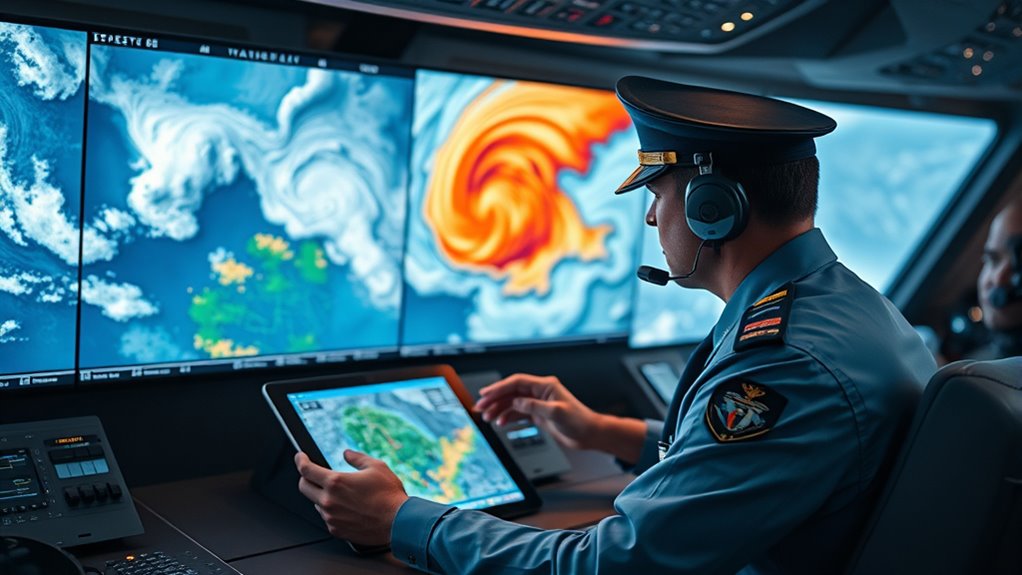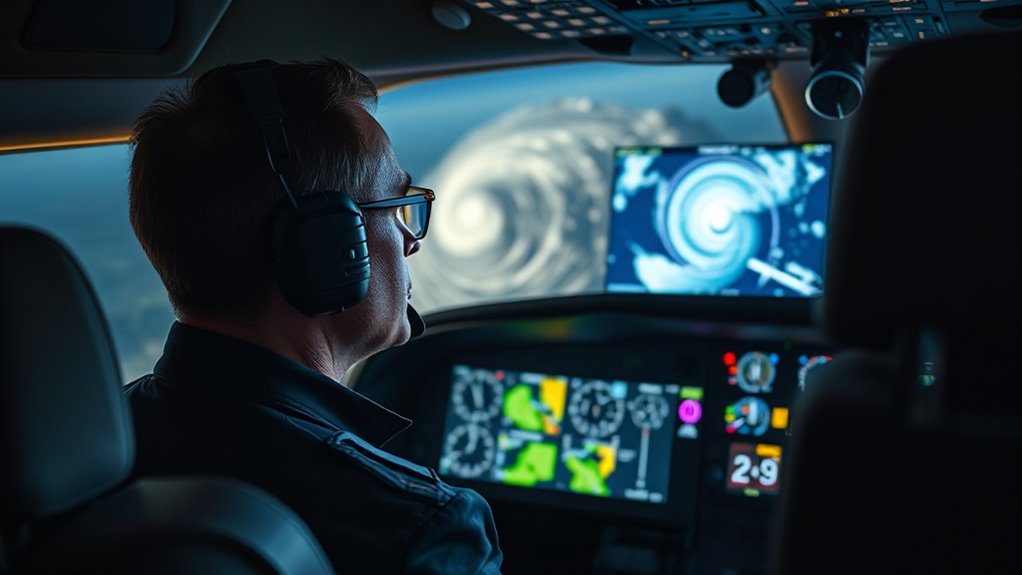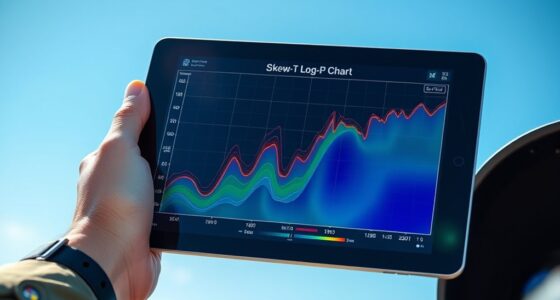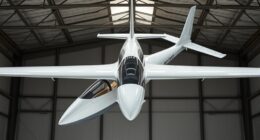To guarantee safe, efficient flights in 2025 and beyond, prioritize thorough pre-flight weather briefings using the latest technology like real-time radar, satellite data, and digital updates on tablets or cockpit systems. Develop skills to interpret METARs, TAFs, and graphical forecasts accurately, and stay current on emerging weather tools. Incorporating these best practices helps you anticipate hazards, adjust plans proactively, and make smarter decisions—plus, there’s more to explore on how to optimize your approach further.
Key Takeaways
- Utilize advanced digital tools and real-time data for comprehensive and up-to-date weather briefings.
- Prioritize thorough review of METARs, TAFs, and graphical forecasts to assess hazards accurately.
- Incorporate innovative weather technologies like high-resolution Doppler radar and satellite imagery into planning.
- Ensure continuous training on emerging weather analysis tools and interpretation techniques.
- Integrate weather updates seamlessly into pre-flight routines to enhance safety and operational efficiency.

Before you take off, a thorough pre-flight weather briefing is essential to guarantee a safe and smooth journey. As a pilot or flight planner, you understand that aviation safety heavily depends on your ability to interpret weather conditions accurately. With advancements in weather technology, you now have access to more precise and real-time data than ever before. Leveraging these tools effectively can make all the difference, helping you anticipate hazards and adapt your flight plan accordingly. In 2025 and beyond, integrating the latest weather technology into your pre-flight routine isn’t just recommended; it’s indispensable for maintaining safety standards and operational efficiency.
Modern weather technology provides detailed forecasts, radar imagery, satellite data, and wind shear alerts, all of which are essential for making informed decisions. These tools enable you to visualize weather patterns along your route, identify areas of turbulence, thunderstorms, or low visibility, and adjust your altitude or routing proactively. For example, high-resolution Doppler radar can reveal developing storm cells, so you can choose to fly around or delay your departure if conditions are adverse. Digital weather briefings, accessible via tablets or integrated cockpit systems, streamline this process, allowing you to review critical information quickly and efficiently. This immediacy often reduces the chance of overlooking vital updates that could compromise aviation safety.
Understanding and interpreting weather data is just as important as having it. You must be skilled in evaluating the severity of weather phenomena and understanding their potential impact on your flight. For instance, turbulence forecasts derived from weather technology can help you prepare your crew and passengers, while wind shear alerts inform you of sudden changes in wind velocity that could affect your aircraft during takeoff or landing. The ability to synthesize multiple data sources, including METARs, TAFs, and graphical forecasts, ensures you get a comprehensive picture of current and anticipated conditions. This holistic approach allows for better risk management, ensuring you’re not caught off guard by unexpected weather developments.
In the context of aviation safety, pre-flight weather briefings must be thorough, current, and tailored to your specific flight plan. Weather technology enhances your situational awareness, but it’s your expertise in interpreting that data which ultimately safeguards your operation. Regular training on emerging weather tools and updates on the latest technology trends keep you sharp and prepared. By making weather briefings a disciplined part of your pre-flight routine, you maximize safety, optimize fuel efficiency, and reduce delays. As weather patterns grow more unpredictable, embracing these best practices with cutting-edge weather technology ensures you’re always one step ahead, flying smarter and safer than ever before.
Frequently Asked Questions
How Will AI Improve Pre-Flight Weather Briefings?
AI will enhance pre-flight weather briefings by providing AI-driven personalization, tailoring information to your specific flight route and aircraft. Predictive analytics will forecast weather patterns more accurately, helping you anticipate potential hazards and plan accordingly. This combination allows for faster, more relevant updates, improving safety and efficiency. You’ll get real-time insights that adapt to changing conditions, making your pre-flight preparations smarter and more reliable.
What Are the Latest Technological Trends in Weather Data Collection?
You’ll see that the latest trend in weather data collection involves advanced weather sensors and seamless data integration. These sensors provide real-time, high-precision atmospheric data, while new integration technologies combine diverse sources for a thorough view. This synergy allows for faster, more accurate weather updates, empowering you to make confident decisions. Staying updated on these innovations ensures you leverage the most reliable information for safer, more efficient flights.
How Can Pilots Customize Weather Updates for Specific Routes?
You can customize weather updates for your specific routes by setting up personalized alerts through your flight planning tools. These alerts provide route-specific data, ensuring you receive timely updates on weather conditions along your planned path. By tailoring your notifications, you stay informed about potential hazards, turbulence, or delays, allowing you to make proactive decisions and enhance safety and efficiency during your flight.
What Role Do Satellite Systems Play in Future Weather Forecasting?
The future of weather forecasting hinges on satellite systems playing a pivotal role. With ongoing satellite advancements, you’ll get more accurate and timely data, allowing for better predictions. Data integration from these satellites will merge with ground-based info, giving you a clear picture of weather patterns. This technology will be your eye in the sky, helping you anticipate hazards before they become a problem, making flying safer and smoother.
How Will International Standards Evolve for Global Weather Briefings?
You’ll see international standards for global weather briefings evolve through greater regulatory harmonization, addressing standardization challenges worldwide. As countries work together, they’ll develop unified protocols, ensuring consistency and accuracy in weather information. This collaborative approach streamlines data sharing, enhances forecast reliability, and improves safety. By embracing harmonized standards, you’ll benefit from more precise, timely weather briefings, ultimately supporting safer, more efficient flight operations across borders.
Conclusion
Staying informed with thorough pre-flight weather briefings can considerably reduce risks and enhance safety. Did you know that pilots who regularly review detailed weather reports are 30% less likely to encounter unexpected conditions? By adopting best practices for 2025 and beyond, you’ll make smarter decisions, ensuring smoother flights. Always prioritize up-to-date weather info—your safety depends on it. Embrace these habits now to navigate tomorrow’s skies confidently and securely.









